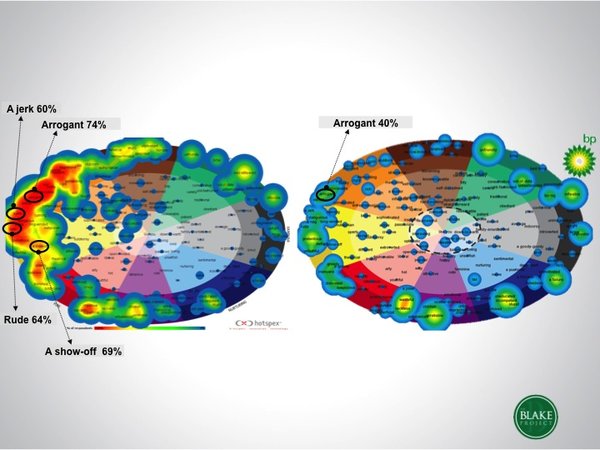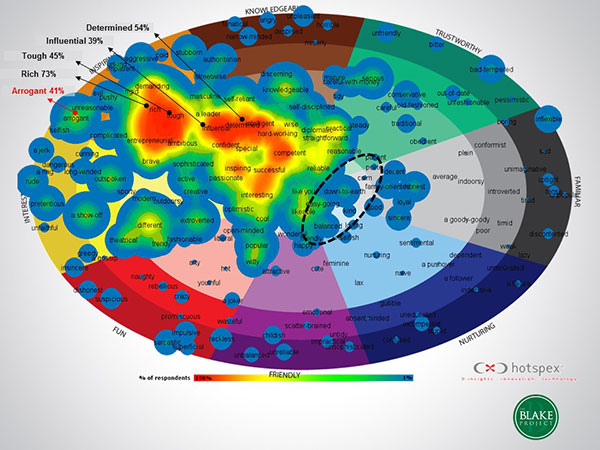Any press is good press, that’s how the adage goes, but for Donald Trump it seems like gospel. The controversial Republican frontrunner for President of the United States has dominated the campaign trail in earned media by remaining the central focus of traditional and social media alike. This is widely known.
But how has this polarizing figure done such a masterful job of commanding the spotlight?
By leveraging the power of divisive emotions.
Behavioral psychology has discovered that negative emotions are felt with three times the mental potency of positive emotions and that they stay in the psyche for prolonged periods of time. At The Blake Project we use quantitative measurements and our specially developed Hotspex map of human emotions to plot how the populace feels about brands, in this case about the Donald Trump brand.
About The Maps
- The maps you see below were specially designed to represent real distances between emotions, e.g. emotions that are more similar will appear closer to each other while those that are more different will be further apart.
- Each of the colored pie pieces represents a group of similar emotions from the most positive at the center to the most negative at the black outer edge.
- The level of “heat” represents the percentage of people who associated that attribute with the Donald Trump brand.
- A “healthy” brand would have lots of heat in the center of the map, lots of heat in at least one of the pie pieces outside of the center, and no heat on the black outer ring where the negative emotions are located.
A healthy brand is exactly the opposite of how Democrats from the opposing party feel about Donald Trump! In fact and not surprisingly, their negative feelings toward Trump are off the chart, as they see him as arrogant (74%), a jerk (60%), show-off (69%) while giving virtually no credit for positive emotions.
It’s precisely these incredibly strong negative emotions that are driving Trump’s share of earned media attention, to levels that even his deep pocketed establishment rivals cannot contend with. So really it’s no surprise that The Donald is enjoying significant mental availability, a measure of how well primed the public’s mental pathways on a given idea are when he elicits such a strong emotional response. In fact, compare that map with how American’s felt about BP after the disastrous Gulf Oil Spill. What do we find? Not even a massive oil spill could generate the negativity that Democrats now feel toward Trump.

In case you thought that only Democrats have negative emotions about the Republican frontrunner, our data shows that Republicans view him as a polarizing figure especially regarding his now iconic arrogance (41% of all Republicans think he is arrogant.). Here is Trump’s map among all Republicans:

Versus his supporters, who clearly see Trump as a leader (the orange zone) and “like me” (44%). And are less likely to see him as arrogant. (23%)

Conventional wisdom says that a candidate that generates such a wide range of emotions across the spectrum should have no chance at influencing public policy. Not so for the Donald Trump brand it would seem, who has ridden the wave of highly politicized emotions to ubiquitous free air time and his own unique version of mental availability. While he remains a highly controversial figure, maybe it’s time to ask, what can your brand learn from the Trump phenomenon?
The first step in building an iconic and thriving brand is to understand where you are today by identifying your brand’s emotional ‘Now Space’. Our BrandInsistence model (first developed at Hallmark) and powered by Hotspex advanced emotional connection technology measures the impact brands have on consumers across 5,000+ possible emotions. To accelerate brand growth, it is critical to identify where your brand is building a positive emotional connection in a way that is important to consumers in that category, so that you can execute consistently within that emotional territory.
Nobel Prize winning research in neuroscience and behavioral economics proves that all humans are irrational, emotional creatures. Both marketers and consumers believe they are in control of their decisions, but research is increasingly proving that assertion wrong. There is something deeper going on at a subconscious emotional level. Marketers that understand this and that harness the power of emotions are today’s true brand builders and are uncovering new opportunities for growth faster than their competitors.
You can too. Simply email me, Derrick Daye for more about how we can help you build emotional connections for your brand.
The Blake Project Can Help: Accelerate Brand Growth Through Powerful Emotional Connections
Branding Strategy Insider is a service of The Blake Project: A strategic brand consultancy specializing in Brand Research, Brand Strategy, Brand Licensing and Brand Education




